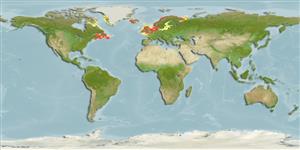Common names from other countries
Environment: milieu / climate zone / depth range / distribution range
Ecología
marino; salobre demersal; no migratorio; rango de profundidad 0 - 100 m (Ref. 48978), usually 0 - 30 m (Ref. 35388). Polar; 72°N - 43°N, 76°W - 45°E
North Atlantic: Kanin Peninsula southward to La Rochelle (including White Sea, North Sea and Baltic), also Iceland, but not eastern Greenland, Spitzbergen or Novaya Zemlya. Western Atlantic: Labrador, Canada to Delaware Bay, USA (Ref. 7251).
Tamaño / Peso / Age
Maturity: Lm ? range ? - ? cm
Max length : 25.0 cm SL macho / no sexado; (Ref. 4693); edad máxima reportada: 5 años (Ref. 72462)
Ribbon - shaped body with 9 - 13 eye spots along the base of the dorsal fin (Ref. 35388).
Facultative air-breathing (Ref. 126274); Occurs in shallow waters (seashore, tide pools), but descends (especially in winter) to 100 m or more. May remain out of water under rocks or seaweeds (Ref. 31184). Feeds on small crustaceans, polychaetes, mollusks and fish eggs. The eggs are laid on the sea bed in a large clump, which is closely guarded until hatched (Ref. 9900). Breathes air when out of water (Ref. 31184). Spawning occur in November - January . Female lays 80-200 eggs in a large ball under a stone or in an empty bivalve shell (Ref. 35388).
Male and female coil around the egg ball (Ref. 58332).
Makushok, V.M., 1986. Pholididae. p. 1124-1125. In P.J.P. Whitehead, M.-L. Bauchot, J.-C. Hureau, J. Nielsen and E. Tortonese (eds.) Fishes of the North-eastern Atlantic and the Mediterranean. UNESCO, Paris. Vol. 3. (Ref. 4693)
IUCN Red List Status (Ref. 130435)
CITES (Ref. 128078)
Not Evaluated
Threat to humans
Harmless
Human uses
Pesquerías: sin interés; Acuario: Comercial
Herramientas
Special reports
Download XML
Fuentes de Internet
Estimates based on models
Preferred temperature (Ref.
115969): 4.3 - 11.9, mean 9.5 (based on 692 cells).
Phylogenetic diversity index (Ref.
82804): PD
50 = 0.5005 [Uniqueness, from 0.5 = low to 2.0 = high].
Bayesian length-weight: a=0.00209 (0.00110 - 0.00398), b=3.17 (3.00 - 3.34), in cm Total Length, based on LWR estimates for this species & (Sub)family-body (Ref.
93245).
Nivel trófico (Ref.
69278): 3.5 ±0.46 se; based on food items.
Resiliencia (Ref.
120179): Medio, población duplicada en un tiempo mínimo de 1.4-4.4 años (tm=1-3; K=0.18-0.29; tmax=12).
Fishing Vulnerability (Ref.
59153): Low to moderate vulnerability (34 of 100).
